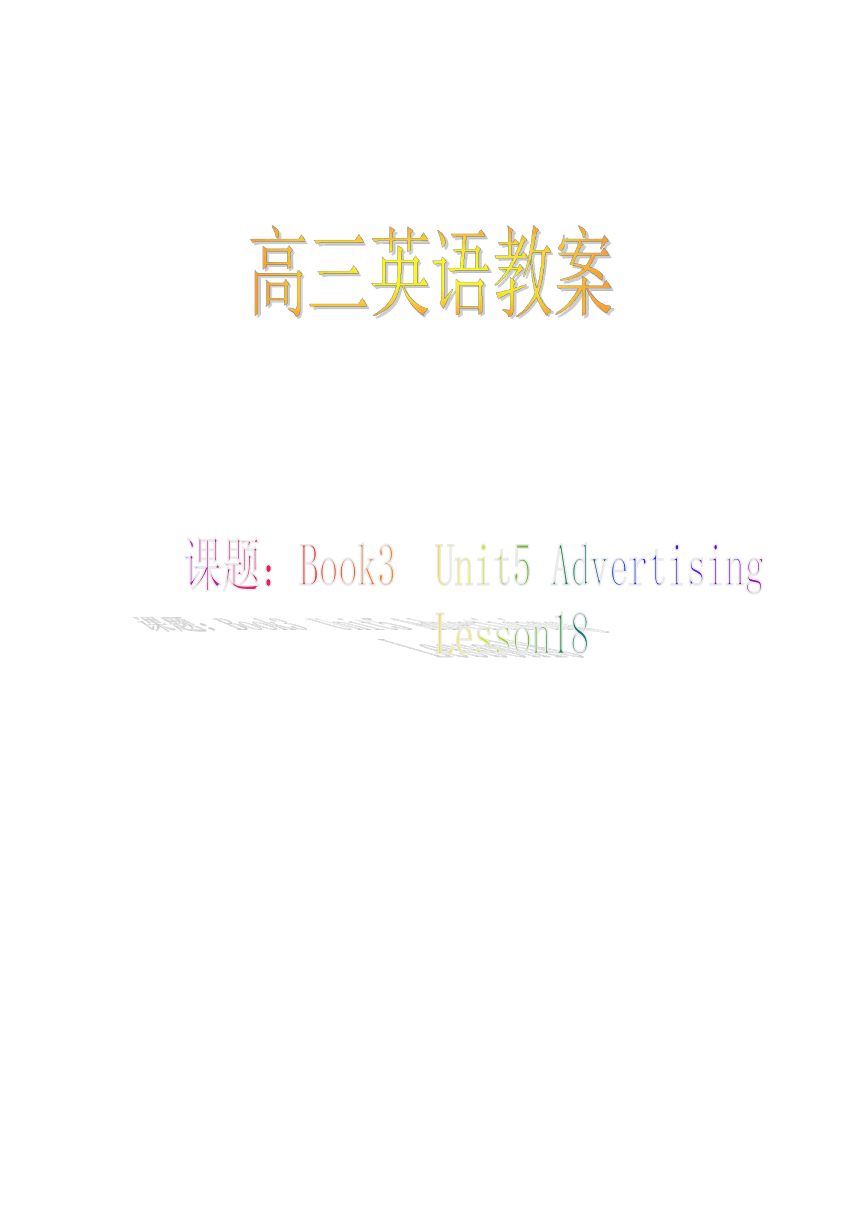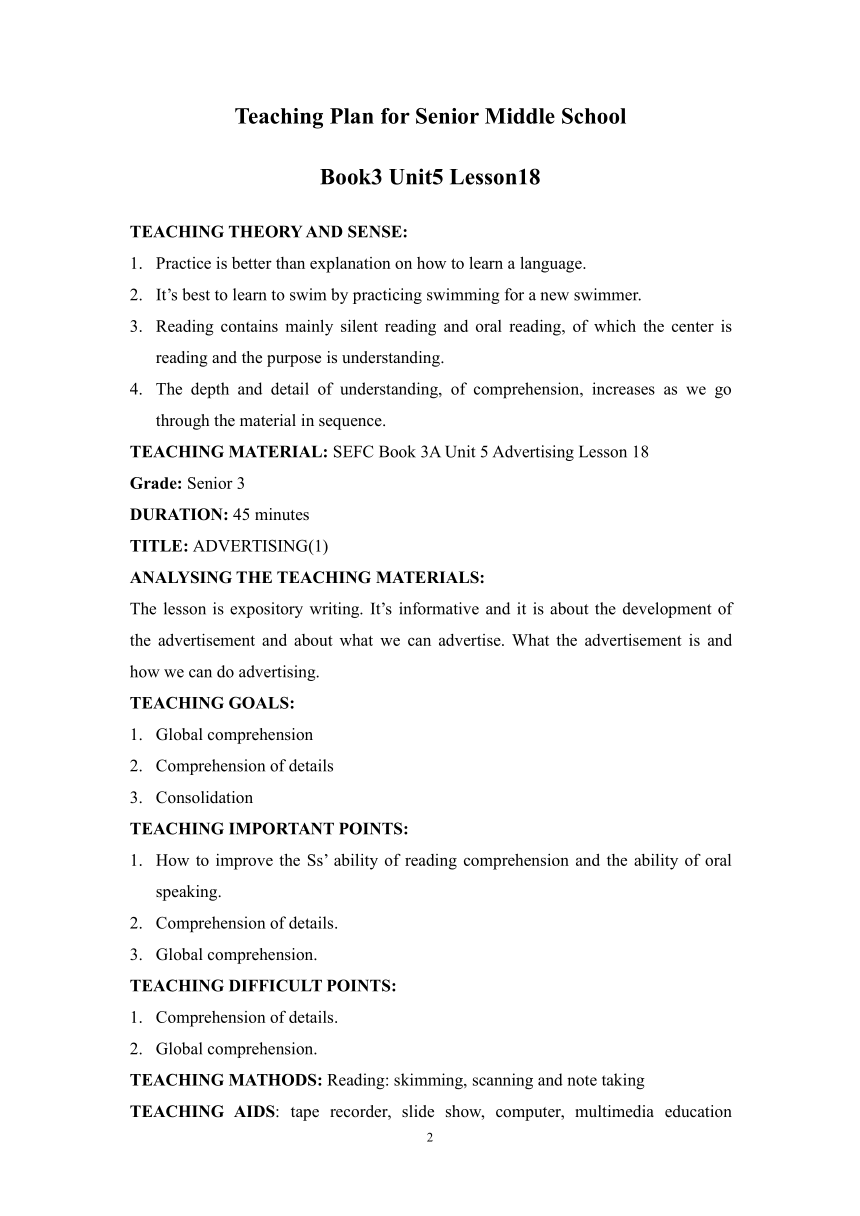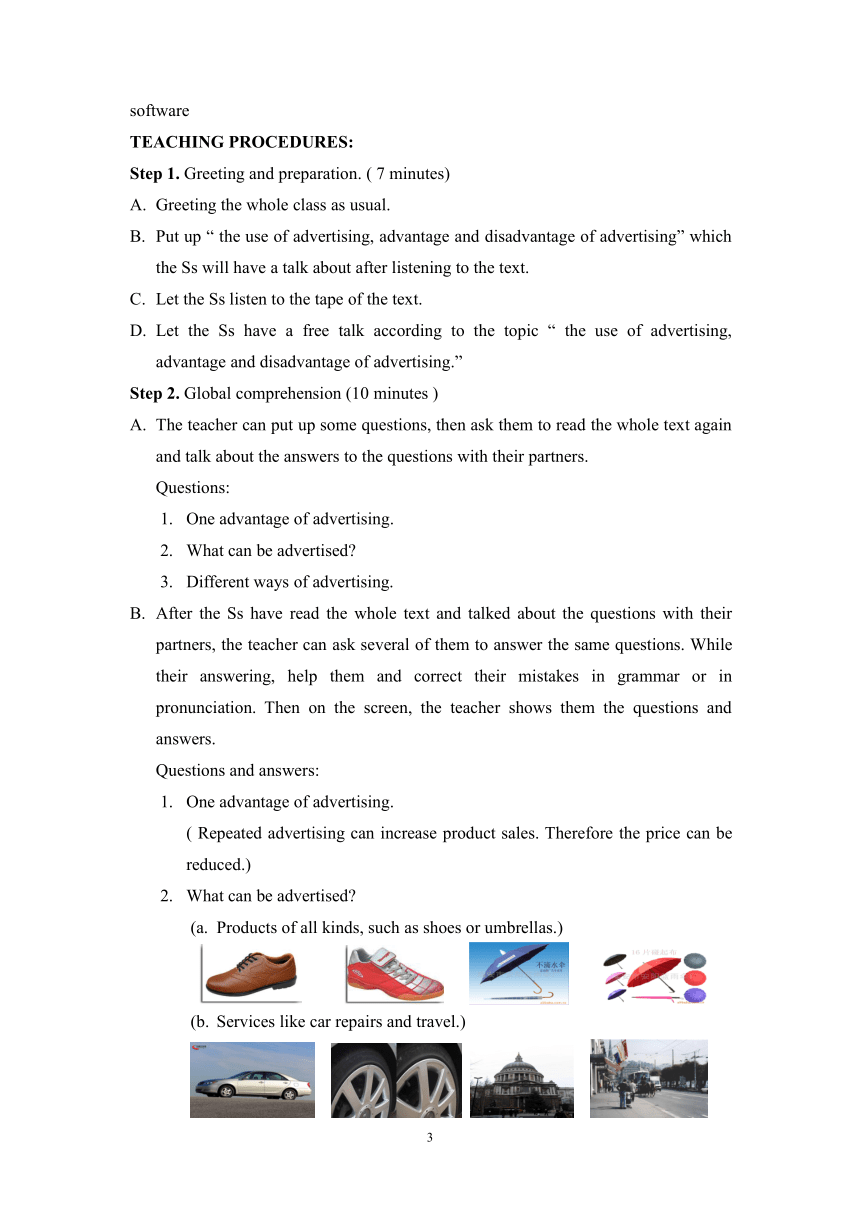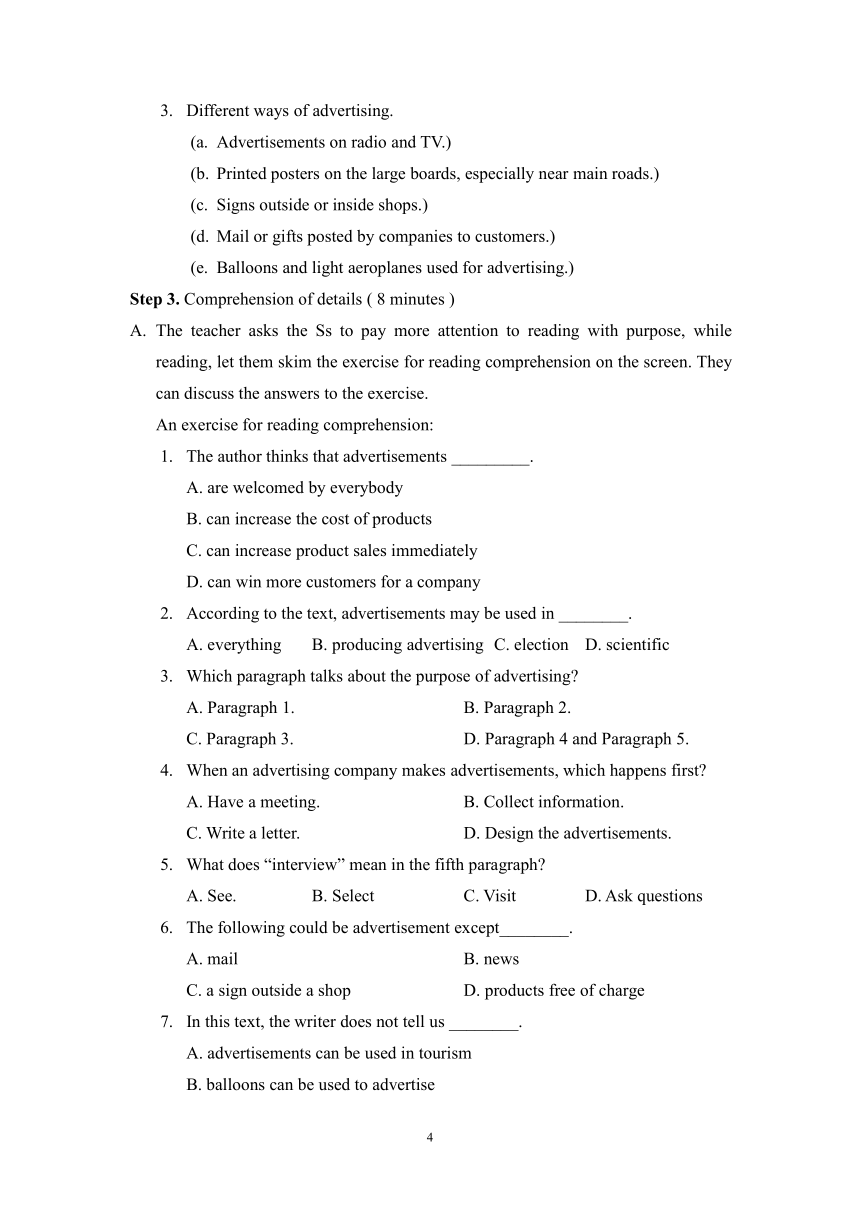Teaching Plan for Senior Middle School[上学期]
文档属性
| 名称 | Teaching Plan for Senior Middle School[上学期] |  | |
| 格式 | rar | ||
| 文件大小 | 418.1KB | ||
| 资源类型 | 教案 | ||
| 版本资源 | 通用版 | ||
| 科目 | 英语 | ||
| 更新时间 | 2006-09-05 23:45:00 | ||
图片预览




文档简介
Teaching Plan for Senior Middle School
Book3 Unit5 Lesson18
TEACHING THEORY AND SENSE:
1. Practice is better than explanation on how to learn a language.
2. It’s best to learn to swim by practicing swimming for a new swimmer.
3. Reading contains mainly silent reading and oral reading, of which the center is reading and the purpose is understanding.
4. The depth and detail of understanding, of comprehension, increases as we go through the material in sequence.
TEACHING MATERIAL: SEFC Book 3A Unit 5 Advertising Lesson 18
Grade: Senior 3
DURATION: 45 minutes
TITLE: ADVERTISING(1)
ANALYSING THE TEACHING MATERIALS:
The lesson is expository writing. It’s informative and it is about the development of the advertisement and about what we can advertise. What the advertisement is and how we can do advertising.
TEACHING GOALS:
1. Global comprehension
2. Comprehension of details
3. Consolidation
TEACHING IMPORTANT POINTS:
1. How to improve the Ss’ ability of reading comprehension and the ability of oral speaking.
2. Comprehension of details.
3. Global comprehension.
TEACHING DIFFICULT POINTS:
1. Comprehension of details.
2. Global comprehension.
TEACHING MATHODS: Reading: skimming, scanning and note taking
TEACHING AIDS: tape recorder, slide show, computer, multimedia education software
TEACHING PROCEDURES:
Step 1. Greeting and preparation. ( 7 minutes)
A. Greeting the whole class as usual.
B. Put up “ the use of advertising, advantage and disadvantage of advertising” which the Ss will have a talk about after listening to the text.
C. Let the Ss listen to the tape of the text.
D. Let the Ss have a free talk according to the topic “ the use of advertising, advantage and disadvantage of advertising.”
Step 2. Global comprehension (10 minutes )
A. The teacher can put up some questions, then ask them to read the whole text again and talk about the answers to the questions with their partners.
Questions:
1. One advantage of advertising.
2. What can be advertised
3. Different ways of advertising.
B. After the Ss have read the whole text and talked about the questions with their partners, the teacher can ask several of them to answer the same questions. While their answering, help them and correct their mistakes in grammar or in pronunciation. Then on the screen, the teacher shows them the questions and answers.
Questions and answers:
1. One advantage of advertising.
( Repeated advertising can increase product sales. Therefore the price can be reduced.)
2. What can be advertised
(a. Products of all kinds, such as shoes or umbrellas.)
(b. Services like car repairs and travel.)
3. Different ways of advertising.
(a. Advertisements on radio and TV.)
(b. Printed posters on the large boards, especially near main roads.)
(c. Signs outside or inside shops.)
(d. Mail or gifts posted by companies to customers.)
(e. Balloons and light aeroplanes used for advertising.)
Step 3. Comprehension of details ( 8 minutes )
A. The teacher asks the Ss to pay more attention to reading with purpose, while reading, let them skim the exercise for reading comprehension on the screen. They can discuss the answers to the exercise.
An exercise for reading comprehension:
1. The author thinks that advertisements _________.
A. are welcomed by everybody
B. can increase the cost of products
C. can increase product sales immediately
D. can win more customers for a company
2. According to the text, advertisements may be used in ________.
A. everything B. producing advertising C. election D. scientific
3. Which paragraph talks about the purpose of advertising
A. Paragraph 1. B. Paragraph 2.
C. Paragraph 3. D. Paragraph 4 and Paragraph 5.
4. When an advertising company makes advertisements, which happens first
A. Have a meeting. B. Collect information.
C. Write a letter. D. Design the advertisements.
5. What does “interview” mean in the fifth paragraph
A. See. B. Select C. Visit D. Ask questions
6. The following could be advertisement except________.
A. mail B. news
C. a sign outside a shop D. products free of charge
7. In this text, the writer does not tell us ________.
A. advertisements can be used in tourism
B. balloons can be used to advertise
C. advertising may make a product cheaper
D. advertisement in Europe is more common than that in Asia
8. What is very important in an advertisement
A. Question B. Information C. Humor D. A story
9. People read advertisements for ________.
A. information B. fun C. killing time D. both A and B
10. What may turn a good advertisement into a bad one
A. Bad translation. B. A question. C. Story D. High price
B. Personal practice.
After the Ss have discussed the answers for a while, the teacher can ask the Ss one by one to give out the answer of each piece, the others can be judges, so as to interact on the Ss themselves.
( Key: 1. D 2. C 3. A 4. B 5. D 6. B 7. D 8. C 9. D 10. A )
Step 4. Language learning. ( 8 minutes )
A. The teacher can ask the Ss to skim the text and find out some difficult language points for the Ss themselves. Then show them additional explanations if necessary.
B. After showing the notes to the text to the Ss, the teacher can let the Ss read them out one by one.
Notes to the text:
1. highly developed = extremely developed, using many different technique
2. have gone hand in hand with = has progressed at the same time as
3. large boards: known as billboards
4. Once managers would say = Once managers used to talk about the money which they spent on advertising in the following way.
5. “ I know … which half.” = I know that much of the money which I spend on advertising is wasted, but I do not know exactly which part of this money is wasted.
6. Also present will be a person: Note the inversion.
7. think up = imagine; invent
8. buy space: technical term for buying part of a page in a newspaper for an advertisement
9. buy time: technical term for buying a period of time on TV for an advertisement ( eg: 15 seconds/ 30 seconds/ 45 seconds/ 1 minute)
10. try it out: try using the advertisement
C. Show the Ss some new words in the text on the screen with explanation of each word in English, then let the whole class read them out.
New words:
1. advantage = sth useful or helpful
2. poster: placard displayed in a public place
3. gift: present
4. aeroplane = plane
5. jokingly: in a joking manner
6. review: go over again in the mind
7. researcher: person who researches
8. failure: failing, lack of success
Step 5. Consolidation. ( 12 minutes )
A. The teacher makes a reading table according to the text , then help the Ss complete the table followed below:
ADVERTISING
The purpose of advertising:
What can be advertised
Ways of advertising:
B. 1. Tell the Ss to ask each other questions with their partners according to the table given on the screen.
2. After the discussion, the teacher shows them the reading table on the screen and help the Ss to have clear answers.
Answers: ADVERTISING
The purpose of advertising: 1. It increases product sales; 2. It reduces prices.
What can be advertised Products, services, political leaders in the western countries, etc.
Ways of advertising: By using radio, TV, cinema, magazines, newspapers, large boards, signs, balloons, messages pulled behind planes and so on.
C. Ask the Ss to read the text again and do the exercise in SB Page 27, Part 2 individually. Then check the answers.
D. Exercises
1. ---We’d better do the job _________. ---Don’t you think it is _________ time
A. hand in hand, waste B. hand by hand, a waste of
C. hand to hand, wasted D. hand in hand, a waste of
2. She _______ a funny game for children to play.
A. thought in B. thought about C. thought over D. thought up
3. The idea seems fine but we need to _______________ in practice.
A. try it out B. try out it C. trying it out D. trying out it
4. Happiness doesn’t necessarily ____________ wealth.
A. go to B. go out C. go with D. go for
( keys to the exercises: 1. D 2. D 3. A 4. C )
E. Homework
1. Read the text fluently.
2. Finish off the exercises in WB.
3. Get ready for Lesson 19
Blackboard design:
Unit 5 Advertising Lesson 18
Questions: Language points:
1. One advantage of advertising 1. highly developed
2. What can be advertised 2. have gone hand in hand with
3. Different ways of advertising 3. once managers would say
Skills: 4. “ I know… which half.”
1. Important sentences 5. Also present will be a person
2. Main ideas 6. think up
7. buy space
8. try out
附加材料 1
An exercise for reading comprehension:
1. The author thinks that advertisements _________.
A. are welcomed by everybody
B. can increase the cost of products
C. can increase product sales immediately
D. can win more customers for a company
2. According to the text, advertisements may be used in ________.
A. everything B. producing advertising C. election D. scientific
3. Which paragraph talks about the purpose of advertising
A. Paragraph 1. B. Paragraph 2.
C. Paragraph 3. D. Paragraph 4 and Paragraph 5.
4. When an advertising company makes advertisements, which happens first
A. Have a meeting. B. Collect information.
C. Write a letter. D. Design the advertisements.
5. What does “interview” mean in the fifth paragraph
A. See. B. Select C. Visit D. Ask questions
6. The following could be advertisement except________.
A. mail B. news
C. a sign outside a shop D. products free of charge
7. In this text, the writer does not tell us ________.
A. advertisements can be used in tourism
B. balloons can be used to advertise
C. advertising may make a product cheaper
D. advertisement in Europe is more common than that in Asia
8. What is very important in an advertisement
A. Question B. Information C. Humor D. A story
9. People read advertisements for ________.
A. information B. fun C. killing time D. both A and B
10. What may turn a good advertisement into a bad one
A. Bad translation. B. A question. C. Story D. High price
附加材料 2
Notes to the text:
1. highly developed = extremely developed, using many different technique
2. have gone hand in hand with = has progressed at the same time as
3. large boards: known as billboards
4. Once managers would say = Once managers used to talk about the money which they spent on advertising in the following way.
5. “ I know … which half.” = I know that much of the money which I spend on advertising is wasted, but I do not know exactly which part of this money is wasted.
6. Also present will be a person: Note the inversion.
7. think up = imagine; invent
8. buy space: technical term for buying part of a page in a newspaper for an advertisement
9. buy time: technical term for buying a period of time on TV for an advertisement ( eg: 15 seconds/ 30 seconds/ 45 seconds/ 1 minute)
10. try it out: try using the advertisement
PAGE
2
Book3 Unit5 Lesson18
TEACHING THEORY AND SENSE:
1. Practice is better than explanation on how to learn a language.
2. It’s best to learn to swim by practicing swimming for a new swimmer.
3. Reading contains mainly silent reading and oral reading, of which the center is reading and the purpose is understanding.
4. The depth and detail of understanding, of comprehension, increases as we go through the material in sequence.
TEACHING MATERIAL: SEFC Book 3A Unit 5 Advertising Lesson 18
Grade: Senior 3
DURATION: 45 minutes
TITLE: ADVERTISING(1)
ANALYSING THE TEACHING MATERIALS:
The lesson is expository writing. It’s informative and it is about the development of the advertisement and about what we can advertise. What the advertisement is and how we can do advertising.
TEACHING GOALS:
1. Global comprehension
2. Comprehension of details
3. Consolidation
TEACHING IMPORTANT POINTS:
1. How to improve the Ss’ ability of reading comprehension and the ability of oral speaking.
2. Comprehension of details.
3. Global comprehension.
TEACHING DIFFICULT POINTS:
1. Comprehension of details.
2. Global comprehension.
TEACHING MATHODS: Reading: skimming, scanning and note taking
TEACHING AIDS: tape recorder, slide show, computer, multimedia education software
TEACHING PROCEDURES:
Step 1. Greeting and preparation. ( 7 minutes)
A. Greeting the whole class as usual.
B. Put up “ the use of advertising, advantage and disadvantage of advertising” which the Ss will have a talk about after listening to the text.
C. Let the Ss listen to the tape of the text.
D. Let the Ss have a free talk according to the topic “ the use of advertising, advantage and disadvantage of advertising.”
Step 2. Global comprehension (10 minutes )
A. The teacher can put up some questions, then ask them to read the whole text again and talk about the answers to the questions with their partners.
Questions:
1. One advantage of advertising.
2. What can be advertised
3. Different ways of advertising.
B. After the Ss have read the whole text and talked about the questions with their partners, the teacher can ask several of them to answer the same questions. While their answering, help them and correct their mistakes in grammar or in pronunciation. Then on the screen, the teacher shows them the questions and answers.
Questions and answers:
1. One advantage of advertising.
( Repeated advertising can increase product sales. Therefore the price can be reduced.)
2. What can be advertised
(a. Products of all kinds, such as shoes or umbrellas.)
(b. Services like car repairs and travel.)
3. Different ways of advertising.
(a. Advertisements on radio and TV.)
(b. Printed posters on the large boards, especially near main roads.)
(c. Signs outside or inside shops.)
(d. Mail or gifts posted by companies to customers.)
(e. Balloons and light aeroplanes used for advertising.)
Step 3. Comprehension of details ( 8 minutes )
A. The teacher asks the Ss to pay more attention to reading with purpose, while reading, let them skim the exercise for reading comprehension on the screen. They can discuss the answers to the exercise.
An exercise for reading comprehension:
1. The author thinks that advertisements _________.
A. are welcomed by everybody
B. can increase the cost of products
C. can increase product sales immediately
D. can win more customers for a company
2. According to the text, advertisements may be used in ________.
A. everything B. producing advertising C. election D. scientific
3. Which paragraph talks about the purpose of advertising
A. Paragraph 1. B. Paragraph 2.
C. Paragraph 3. D. Paragraph 4 and Paragraph 5.
4. When an advertising company makes advertisements, which happens first
A. Have a meeting. B. Collect information.
C. Write a letter. D. Design the advertisements.
5. What does “interview” mean in the fifth paragraph
A. See. B. Select C. Visit D. Ask questions
6. The following could be advertisement except________.
A. mail B. news
C. a sign outside a shop D. products free of charge
7. In this text, the writer does not tell us ________.
A. advertisements can be used in tourism
B. balloons can be used to advertise
C. advertising may make a product cheaper
D. advertisement in Europe is more common than that in Asia
8. What is very important in an advertisement
A. Question B. Information C. Humor D. A story
9. People read advertisements for ________.
A. information B. fun C. killing time D. both A and B
10. What may turn a good advertisement into a bad one
A. Bad translation. B. A question. C. Story D. High price
B. Personal practice.
After the Ss have discussed the answers for a while, the teacher can ask the Ss one by one to give out the answer of each piece, the others can be judges, so as to interact on the Ss themselves.
( Key: 1. D 2. C 3. A 4. B 5. D 6. B 7. D 8. C 9. D 10. A )
Step 4. Language learning. ( 8 minutes )
A. The teacher can ask the Ss to skim the text and find out some difficult language points for the Ss themselves. Then show them additional explanations if necessary.
B. After showing the notes to the text to the Ss, the teacher can let the Ss read them out one by one.
Notes to the text:
1. highly developed = extremely developed, using many different technique
2. have gone hand in hand with = has progressed at the same time as
3. large boards: known as billboards
4. Once managers would say = Once managers used to talk about the money which they spent on advertising in the following way.
5. “ I know … which half.” = I know that much of the money which I spend on advertising is wasted, but I do not know exactly which part of this money is wasted.
6. Also present will be a person: Note the inversion.
7. think up = imagine; invent
8. buy space: technical term for buying part of a page in a newspaper for an advertisement
9. buy time: technical term for buying a period of time on TV for an advertisement ( eg: 15 seconds/ 30 seconds/ 45 seconds/ 1 minute)
10. try it out: try using the advertisement
C. Show the Ss some new words in the text on the screen with explanation of each word in English, then let the whole class read them out.
New words:
1. advantage = sth useful or helpful
2. poster: placard displayed in a public place
3. gift: present
4. aeroplane = plane
5. jokingly: in a joking manner
6. review: go over again in the mind
7. researcher: person who researches
8. failure: failing, lack of success
Step 5. Consolidation. ( 12 minutes )
A. The teacher makes a reading table according to the text , then help the Ss complete the table followed below:
ADVERTISING
The purpose of advertising:
What can be advertised
Ways of advertising:
B. 1. Tell the Ss to ask each other questions with their partners according to the table given on the screen.
2. After the discussion, the teacher shows them the reading table on the screen and help the Ss to have clear answers.
Answers: ADVERTISING
The purpose of advertising: 1. It increases product sales; 2. It reduces prices.
What can be advertised Products, services, political leaders in the western countries, etc.
Ways of advertising: By using radio, TV, cinema, magazines, newspapers, large boards, signs, balloons, messages pulled behind planes and so on.
C. Ask the Ss to read the text again and do the exercise in SB Page 27, Part 2 individually. Then check the answers.
D. Exercises
1. ---We’d better do the job _________. ---Don’t you think it is _________ time
A. hand in hand, waste B. hand by hand, a waste of
C. hand to hand, wasted D. hand in hand, a waste of
2. She _______ a funny game for children to play.
A. thought in B. thought about C. thought over D. thought up
3. The idea seems fine but we need to _______________ in practice.
A. try it out B. try out it C. trying it out D. trying out it
4. Happiness doesn’t necessarily ____________ wealth.
A. go to B. go out C. go with D. go for
( keys to the exercises: 1. D 2. D 3. A 4. C )
E. Homework
1. Read the text fluently.
2. Finish off the exercises in WB.
3. Get ready for Lesson 19
Blackboard design:
Unit 5 Advertising Lesson 18
Questions: Language points:
1. One advantage of advertising 1. highly developed
2. What can be advertised 2. have gone hand in hand with
3. Different ways of advertising 3. once managers would say
Skills: 4. “ I know… which half.”
1. Important sentences 5. Also present will be a person
2. Main ideas 6. think up
7. buy space
8. try out
附加材料 1
An exercise for reading comprehension:
1. The author thinks that advertisements _________.
A. are welcomed by everybody
B. can increase the cost of products
C. can increase product sales immediately
D. can win more customers for a company
2. According to the text, advertisements may be used in ________.
A. everything B. producing advertising C. election D. scientific
3. Which paragraph talks about the purpose of advertising
A. Paragraph 1. B. Paragraph 2.
C. Paragraph 3. D. Paragraph 4 and Paragraph 5.
4. When an advertising company makes advertisements, which happens first
A. Have a meeting. B. Collect information.
C. Write a letter. D. Design the advertisements.
5. What does “interview” mean in the fifth paragraph
A. See. B. Select C. Visit D. Ask questions
6. The following could be advertisement except________.
A. mail B. news
C. a sign outside a shop D. products free of charge
7. In this text, the writer does not tell us ________.
A. advertisements can be used in tourism
B. balloons can be used to advertise
C. advertising may make a product cheaper
D. advertisement in Europe is more common than that in Asia
8. What is very important in an advertisement
A. Question B. Information C. Humor D. A story
9. People read advertisements for ________.
A. information B. fun C. killing time D. both A and B
10. What may turn a good advertisement into a bad one
A. Bad translation. B. A question. C. Story D. High price
附加材料 2
Notes to the text:
1. highly developed = extremely developed, using many different technique
2. have gone hand in hand with = has progressed at the same time as
3. large boards: known as billboards
4. Once managers would say = Once managers used to talk about the money which they spent on advertising in the following way.
5. “ I know … which half.” = I know that much of the money which I spend on advertising is wasted, but I do not know exactly which part of this money is wasted.
6. Also present will be a person: Note the inversion.
7. think up = imagine; invent
8. buy space: technical term for buying part of a page in a newspaper for an advertisement
9. buy time: technical term for buying a period of time on TV for an advertisement ( eg: 15 seconds/ 30 seconds/ 45 seconds/ 1 minute)
10. try it out: try using the advertisement
PAGE
2
